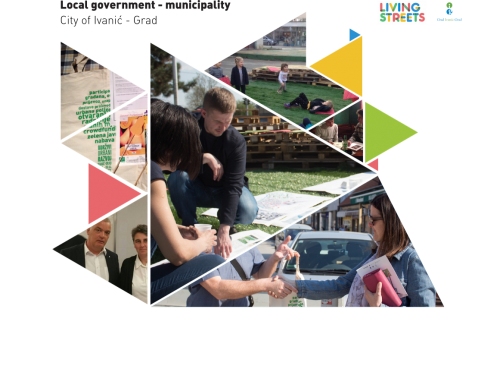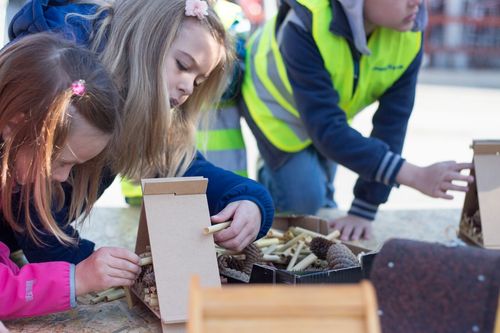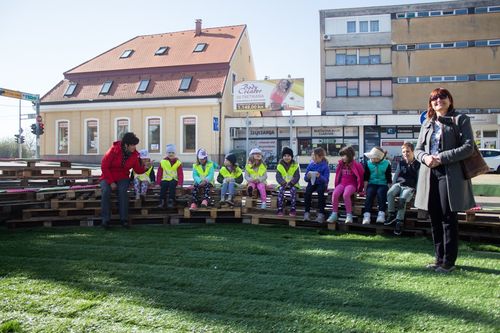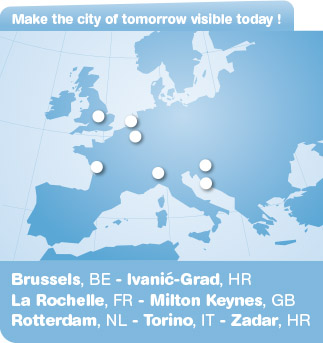Ivanic-Grad, Croatia
The objectives of the Living Streets in Ivanić-Grad
(14,000 inhabitants) are to prepare the ground for the creation of a
pedestrian city centre, promote bicycles as a means of transport,
support local production and consumption and encourage circular economy.
The municipality aims to attract young people to live in Ivanić-Grad
after finishing their studies as well as change people’s mind-sets
regarding the individual use of cars and unsustainable consumption
models. For this purpose, the municipality is linked to different local
businesses and citizens and is moving from a top down approach to a
bottom up and co-creative one.
Context
The city of Ivanić-Grad is well developed thanks to gas and oil
resources, but this has a negative impact on the local environment. The
city also faces two important demographic issues: aging population and
emigration. Due to the prolonged economic crisis, there are currently
empty commercial spaces in the city centre, as well as abandoned land
suitable for agriculture. This land belongs to the municipality, to the
ministry of agriculture and to private owners who moved out of
Ivanić-Grad.

Local food production and consumption, circular economy and changing of mind-sets
In order to address the issue of local food production, in the first
edition of Living Streets the municipality organised a pumpkin
production contest to attract citizens to the Living Streets initiative
and link with an existing popular event: the pumpkin fest.
To all the citizens who filled in the application form, the Mayor of
Ivanić-Grad distributed 100 urban gardening sets, including pumpkin
seeds, tools for gardening, labels for seeds and instructions. In this
framework, the municipal owned land was temporarily offered to citizens
who live in multi-apartment buildings and do not own gardens to use it
for urban gardening. Their results encouraged them to continue in the
coming years, creating a demand for more land for the future Living
Streets editions.
Therefore, the municipality is relaying with the national ministry of
agriculture to use the plots of currently abandoned land. The
municipality is also discussing with citizens who do not use their land
in order to make it available for urban gardening. Local family farms
expressed interest to buy the locally produced vegetables and fruits.
Citizens and local businesses were therefore connected by the
municipality to collaborate in the future.
"As a Deputy Mayor, I have been following the Living Streets
Project since the very beginning because I felt it could be very
beneficial to our citizens.
During the project I was actively involved in urban gardening. Citizens
motivated by my own example of planting pumpkins, started planting them
as well. At the end of a successful gardening season, we organized a
seed exchange and prepared ourselves for the next season.
I think citizens will continue to partake in this interesting project
even after its official ending and encourage each other in planting
pumpkins which will contribute to strengthening the traditional city
manifestation." (Željko Posilović, Deputy Mayor, City of Ivanić-Grad)

An urban gardening workshop was set up, including distribution of
specific toolkits for citizens (pumpkin seeds, tools for gardening,
labels for flower beds and instructions). In October the citizens will
present their results via a competition (for example: the best pumpkin
cake).
Also 4 schools and 4 kindergardens participated via an urban agriculture
process focusing on aromatic herbs. Several highshools and NGOs were
also involved, namely the Red Cross working with citizens with
disabilities.
Furthermore, Living Streets offered the opportunity to exchange
experience with Macedonian experts on agriculture production leading to
an international trading contract signed between businesses from
Ivanić-Grad and experts from Macedonia. In this framework, Macedonian
expertise will be transferred to Ivanić and in turn, Ivanić will export
innovative products developed within the Living Streets such as urban
gardening sets, pumpkin seeds, local eco-toys and eco-devices prepared
by local designers and companies. From a social perspective, the project
is expected to link up many citizens in Ivanić who are from Macedonia
and it is likely that they will reconnect with their families from
Macedonia.
In the framework of Living Streets, the municipality encouraged small
businesses to cooperate and to communicate on common goals they are
reaching for and not to see themselves as competitors. Thus, the NGO
Brenta was created to regroup wine producers in order to help them
cooperate better. Many produce Škrlet wine, leading to the organisation
of a new local event: the festival of the Škrlet wine. They are also now
responding together to large market demands for local wine, to which
they cannot respond individually. The municipality acted here as a
facilitator encouraging networking within its territory by connecting
people and businesses.
Ivanić-Grad also organised a local workshop on crowdfunding to link
up students and existing and future local producers with two goals:
future orientation of the students from the middle school and set up
local businesses. As a result, a local cookie factory will be opened,
the local bakery developed new products and urban furniture for Living
Streets on the main square. Also gardening toolkits and insect hotels
were produced thanks to Living Streets connecting Design students who
designed the elements, skilled pensioners who pre-crafted the elements
according to the drawings and kindergarten children who assembled them.
All this got together at the main city square during the green
living-room events in Ivanić. So, after the crowdfunding crash-course,
the students are considering a start-up in urban design now.
All that it took to make this a true social innovation is the local
radio station sharing the right news, passionate handy pensioners,
creative and proactive design students and open-minded municipal
staff…gathered together via Living Streets in Ivanić.
Local consumption and awareness raising
During the Christmas period, the municipality encouraged the citizens
to buy local presents (food, drinks, toys). It turned out that many
citizens did not know where to buy these products locally, nor did they
know who the local producers were and whether they had a shop. To solve
this issue, in the main square an exhibition office was built
temporarily and local producers could sell their products there prior to
the Christmas period. This proved to be very successful. Thanks to
Living Streets, the mind-sets of the citizens are changing regarding the
importance of local production and on their consumption habits.
A local pedestrian city centre
In the past, the municipality envisaged to close the city centre to
cars, but this was perceived as an unpopular measure at the time.
During the Living Streets, this car free city centre was experienced
twice for two weeks during different periods in 2017. At first local
businesses and shop owners were worried that their sales would decrease.
However, during the urban workshop they understood that even if the
square is closed to cars they would still be able to deliver goods.
Besides, when they realised that citizens are asking for the square to
be pedestrian, they understood that this might be an opportunity for
them. The municipality promised to do some communication activities to
promote their businesses. Positive results from other European cities
were shown to prove that car-free city centres do not come only with
problems, but also with solutions.

After experimenting and evaluating, the following conclusions were drawn:
- Young citizens and the families with kids see the
main square as a safe and thrilling place with green spaces,
playgrounds, cafés.
- On the other hand, other citizens
(especially middle aged males) voted against closing the main square to
cars (they usually can park their individual car in front of the shops).
-
It is felt that activities organised within the Living Streets were
still not sufficient to change the mind-sets completely and help
citizens see that it is much healthier to bike and to walk.
- To
make a pedestrian square, budget is required for infrastructure and this
is not included in the municipal budget for the next two years.
However, experts within the project suggested some soft activities and
minor works that do not require a huge budget.
In the near future, the municipality of Ivanić will need to change
its urban plans especially related to the historic city centre. It is
planned to organise another urban workshop and citizens will be invited
again to express their opinions, needs and suggestions.
Only political commitment and a decision from the mayor to close the
square for a longer period, for instance six month, can have a bigger
effect and allow city officials and citizens to better assess the
acceptance and impact of a pedestrian main square in Ivanić.
Contact
Vlatka Berlan Vlahek, Municipality of Ivanic-Grad
Further information:
www.facebook.com/livingstreetivg/







